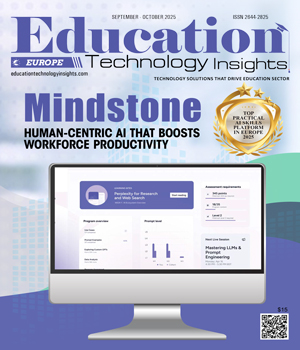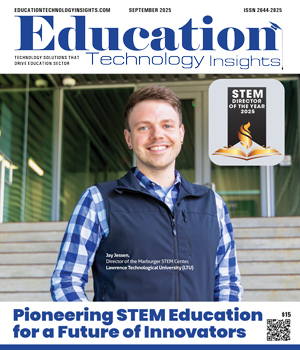THANK YOU FOR SUBSCRIBING
Be first to read the latest tech news, Industry Leader's Insights, and CIO interviews of medium and large enterprises exclusively from Education Technology Insights
Building Practical Readiness in Cybersecurity Talent
Dan Han, Chief Information Security Officer, Virginia Commonwealth University
 Dan Han, Chief Information Security Officer, Virginia Commonwealth University
Dan Han, Chief Information Security Officer, Virginia Commonwealth UniversityAs a cybersecurity practitioner and professor, Dan Han spent several years helping students bridge the gap between classroom learning and real-world cybersecurity work. After serving on nonprofit boards and advising universities on hands-on curriculum, he moved into teaching, redesigning courses to include cloud technologies, zero-trust security strategies and practical experience. Combining theory with applied skills, Han focuses on preparing the next generation of professionals to meet the evolving challenges of cybersecurity.
Through this article, Han emphasizes the need to bridge academia and industry by pairing theory with fostering dialogue between educators and employers to ensure graduates are workforce-ready from day one.
Adapting Curriculum to Emerging Threats and Technologies
I start my day scanning sources for new vulnerabilities, organizational technology and cybersecurity developments or shifts in generative AI before meetings or classes. This ensures I protect my organization from emerging threats while bringing current insights to students.
As both practitioner and educator, I keep the program dynamic. Each semester, and sometimes weekly, I refine content to reflect real-world events. For instance, during a lecture on cloud computing fundamentals, news broke of hackers exploiting a Salesforce plugin. I used it as a case study to connect theory with practice.
The most pressing issue is academic integrity. Tools like ChatGPT let students produce polished work without fully engaging. In 2022, programming assignments showed varied quality; by late 2023, with ChatGPT widespread, submissions improved. Students were clearly relying on AI.
Rather than resisting this, I chose to adapt. By spring 2024, assignments allowed either self-written code or AI-assisted code, provided students included their interaction transcript. This way, I can assess technical skills and their ability to use AI responsibly. Building on this foundation, I incorporated prompt engineering and Generative AI architecture into my course, teaching students to ask effective questions and evaluate AI outputs. These skills are essential for modern and future technology workplaces where AI coding agents are part of daily workflows.
Generative AI is reshaping engineers’ work, making them more efficient and productive. As educators, we cannot ignore this. Our responsibility is to instill strong fundamentals while preparing students to coexist with disruptive technologies. AI is here to stay, and the next generation must be ready to use it effectively.
Improving Student Engagement and Credibility with Technology Education
Teachers’ instruction must combine conceptual knowledge with hands-on experience to prepare students for careers in cybersecurity and cloud computing.
A key part of my approach is using Amazon Web Services (AWS) Academy. Through this platform, students receive individual assignments to build and configure cloud infrastructure directly within AWS. Each student is given credits to access AWS, allowing them to set up servers, configure networks and deploy applications in a real environment. This transforms abstract concepts into practical skills.
These practical skills help them to enter the workforce. When it comes to infrastructure and cloud computing, AWS, Microsoft Azure and Google Cloud Platform lead the industry. By working with these platforms, students gain practical skills in the same environment used daily by leading enterprises. This alignment between education and industry strengthens the credibility of their training.
“Industry cannot expect academia to rewrite programs constantly, and academia cannot remain static in the face of evolving threats. The solution lies in creating hybrid approaches that deliver both academic rigor and industry relevance”
The course is structured to reflect this balance. In the beginning, students learn foundational theory in networking, cloud computing, and security. They then apply this knowledge by building a highly redundant, multi-availability zone application from the ground up. By the end of the course, they have designed a system capable of supporting websites and applications at scale, mirroring the expectations of professional environments.
Certification adds another layer. Aligning programs with certifications, like AWS Foundations, adds credibility and ensures employers can trust new hires’ competencies. This credential validates their capabilities and signals to employers that they are prepared for real-world roles. For hiring organizations, it reduces uncertainty and provides measurable proof of readiness.
Addressing the Challenge of Turning Theory into Workforce Skills
The biggest challenge in cybersecurity is workforce readiness. Across the sector, there’s a gap between what new graduates bring and what organizations truly need.
Students often leave college with strong theoretical knowledge, protocols, frameworks and textbook concepts, but lack the hands-on experience to contribute from day one. Employers typically spend six to nine months training them before they’re fully productive. In the meantime, graduates often start in desktop support or system administration before progressing into cybersecurity.
This gap exists because cybersecurity requires more than theory; it demands broad, applied knowledge of technology operations. Yet accreditation is rigorous, course development is slow, and once curricula are set, they often remain unchanged for years. Industry needs evolve rapidly while academic frameworks lag behind.
Educators with practitioner backgrounds have tried to bridge the gap with experiential learning and internships, but scaling these efforts is difficult. Redesigning even one course takes countless hours, and higher education favors stability over agility.
That’s why bridging strategies are critical. Industry cannot expect academia to constantly rewrite programs, and academia cannot remain static. Hybrid approaches that deliver both rigor and relevance are the way forward.
Key Advice for Aspiring Leaders
Educators must actively seek the perspectives of practitioners. Employers should ask questions like ‘What skills are most valuable in graduates entering the workforce?’ In contrast, academics must reflect on challenges like keeping pace with industry change, balancing theory with practice and working within limited time and resources. Progress comes when both engage in open conversation, listening to one another’s concerns and identifying shared goals. This exchange clarifies expectations and fosters trust and collaboration.
By moving beyond silos, practitioners and academics can align on outcomes that benefit students and institutions alike. The willingness to understand and work together is essential for shaping education that meets the demands of a rapidly evolving workforce.
Read Also
From At-Risk to At-Promise: The Language Revolution Higher Education Needs
Teaching Tomorrow: How Western Governors University Is Redefining Teacher Preparation
Shaping Future Engineers Through Innovation and Hands-On Learning
From Isolation to Interaction: Reimagining Technology for Human Connection
Building an Understanding of AI in Learning Environments
Integrating SEL, Digital Citizenship, and AI Literacy in K–8 Schools

I agree We use cookies on this website to enhance your user experience. By clicking any link on this page you are giving your consent for us to set cookies. More info

However, if you would like to share the information in this article, you may use the link below:
www.educationtechnologyinsightseurope.com/cxoinsights/dan-han-nid-3467.html





















